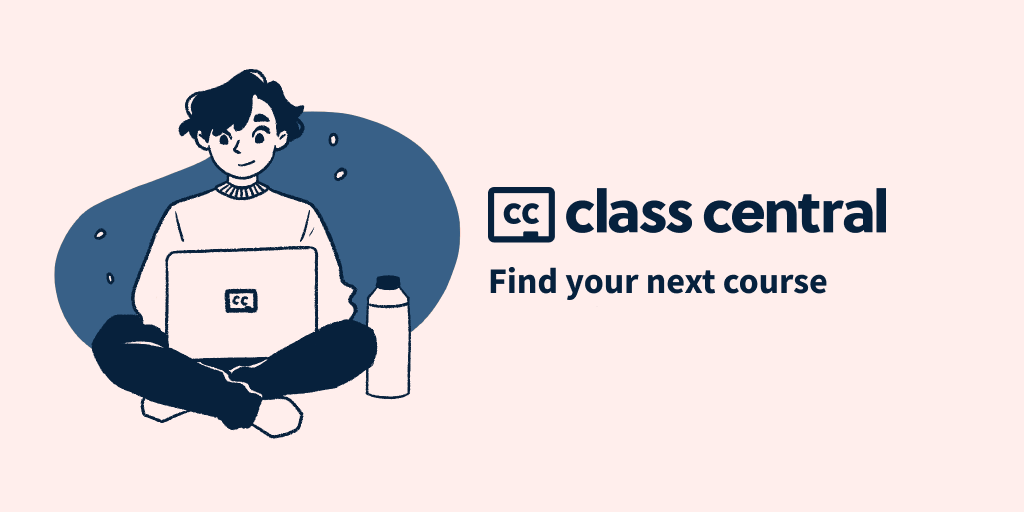10 Best Java Courses to Take in 2024
A guide with the best free and paid online Java courses, a high-level object-oriented programming language that run on Android, Windows, and MacOs.
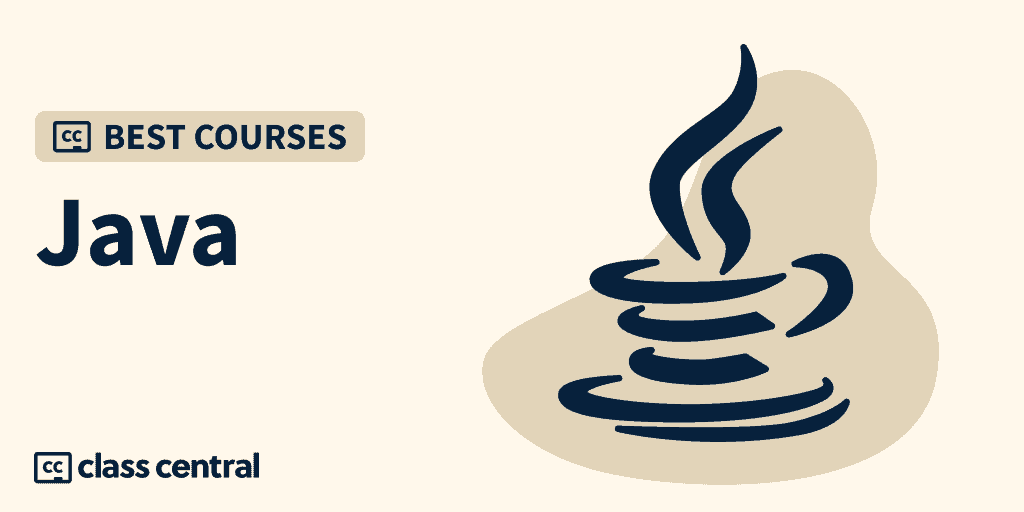
In this guide, I’ve used Class Central’s catalog of over 100K courses to find the best online courses for learning Java.
If you’d like to know how I chose these courses, you can find my methodology below. But if you’re here for the list, here are my top picks. Click on one to skip to the details:
| Course | Workload | In Brief |
| 1. Java Programming I (Helsinki) | 70—140 hours | Best practical course with free certificate |
| 2. Computer Science: Programming with a Purpose (Princeton) | 90—100 hours | Best beginner course focusing on theory |
| 3. Introduction to Java Programming: Starting to code in Java (Carlos iii de Madrid) | 35—50 hours | Best beginner course focusing on object-oriented programming |
| 4. Introduction to Object-Oriented Programming with Java I (Georgia Tech) | 30—36 hours | Great course for beginners focusing on the essentials |
| 5. Intro to Java Programming – Course for Absolute Beginners (fCC) | 4 hours | Best course for the time-constrained |
| 6. Java Programming: Solving Problems with Software (Duke) | 16—32 hours | Introduces wide variety of Java concepts |
| 7. Object Oriented Programming in Java (University of California, San Diego) | 24—36 hours | Intermediate course focusing on application programming |
| 8. Introducción a la programación orientada a objetos en Java (Andes) | 56 hours | Spanish course with a gamified learning experience |
| 9. Java for Beginners (JetBrains) | 75 hours | Integrated into IntellIJ with emphasis on projects |
| 10. Java Programming Masterclass covering Java 11 & Java 17 (Udemy) | 80 hours | Extremely comprehensive beginner course |
What is Java?
Java is a high-level object-oriented programming language with one special characteristic — it is platform independent. Meaning, it can be written once and run on any operating system, from Android to Windows and MacOS.
Instead of compiling directly to machine code, it compiles to Java Bytecode, an intermediary step between pure written Java and machine code. To run the Java Bytecode, a Java Virtual Machine (JVM) for a specific operating system needs to be installed. The JVM interprets the Java Bytecode to produce machine code to be run by the operating system.
Due to Java’s versatility, it has become the third-most popular language according to the TIOBE index. Additionally, Java is simpler than languages like C and C++ which makes it easier to learn for beginners. According to glassdoor, the estimated total pay for a Java developer is $110,713 per year in the United States. So there’s a lot of demand for Java developers!
Course Ranking Methodology
I built this ranking following the now tried-and-tested methodology used in previous rankings (you can find them all here). It involves a three-step process:
- Research: I started by leveraging Class Central’s database with 100K+ online courses and 200K reviews. Then, I made a preliminary selection of 1000+ Java courses by rating, reviews, and bookmarks.
- Evaluate: I read through reviews on Class Central, Reddit, and course providers to understand what other learners thought about each course and combined it with my own experience as a learner.
- Select: Well-made courses were picked if they presented valuable and engaging content and they have to fit in a set of criteria and be ranked accordingly: comprehensive curriculum, selling price, release date, ratings and enrollments.
After going through this process — combining Class Central data, my experience as lifelong learners, and a lot of editing — we arrived at our final ranking. So far, I’ve spent more than 10 hours building this ranking, and I intend to continue updating it in the future.
Course Ranking Statistics
Here are some aggregate stats about the ranking:
- The largest course in this ranking has 670K enrollments.
- Together, they account for 1.8M enrollments.
- 8 courses are free or free-to-audit, while 2 are paid.
- 9 courses are in English, while 1 course is in Spanish.
- About 10.5K people are following Java Courses on Class Central.
Without further ado, let’s go through the top picks.
1. Java Programming I (University of Helsinki)
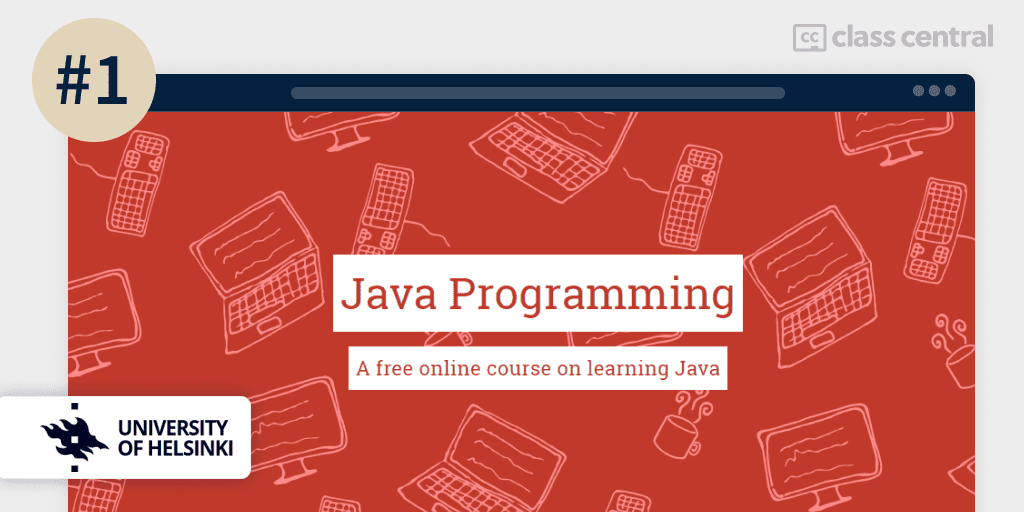
The #1 spot for the best free Java course has to go to Java Programming I from the University of Helsinki. You should definitely try out this MOOC before anything else in this ranking.
This rigorous course will bring you from a complete newbie to programming to an intermediate Java programmer, thanks to its comprehensive syllabus and loads of programming exercises complete with solutions and automated testing. Not only that, but it also has an active telegram group staffed by volunteers! What more could you ask for from a free course? Oh, not to mention that it also offers a free certificate.
Another special thing about this MOOC is that it integrates with a code editor called NetBeans, giving you experience working with industry-grade tools from day one.
By the end of the course, you’ll have the basics of computer programming down, along with algorithms and object-oriented programming.
What You’ll Learn
The course begins with a primer on programming if you’ve never written a single line of code before. You’ll get familiar with the basics of programming like variables, mathematical and logical operators, loops, along with the kind of mindset and tools you should adopt as a programmer — like learning how to break complex problems into simpler, smaller sub-problems, or how to find errors in your code when they inevitably occur with a debugger.
Computers may be powerful, but they certainly aren’t smart! They can only do what they are told — nothing more, nothing less. Hence, the course teaches you some common data structures and algorithms. Data structures tell the computer how to store and represent data, like the grades of students in a class. Meanwhile, algorithms tell the computer how to get information from those data structures, like finding the student with the highest grade in class. The more efficient your implementation of data structures and algorithms are, the faster it takes to retrieve and store information. And speed is highly important especially in a fast-paced world!
You’ll also learn about different programming paradigms, which tells us how to structure our program. Java is an object-oriented programming language, so that’ll be the point of focus in this course. Object-oriented programming is concerned with getting the large picture from many smaller ones. For example, let’s take a regular house. A wall may be yellow or white, a roof may be sloped or flat, a room may be 800 sq ft or 1500 sq ft. But nonetheless, they all share the same characteristic of having walls, floors, rooms, etc but differ in their properties. Object-oriented programming takes this top-down approach to implementing code especially when implementing real-world objects.
How You’ll Learn
The course consists of seven parts, with each part taking approximately 10—20 hours depending on your prior programming abilities. Each part comes with its own exercise sets that are automatically graded. You’ll get a certificate of completion once you have completed at least 80% of the exercises in each part.
| Institution | University of Helsinki |
| Level | Beginner |
| Workload | 70—140 hours total |
| Certificate | Free |
Fun Facts
- By the way, this course is completely open-sourced!
- If you’d rather not use NetBeans, fear not as there is an IntelliJ integration too, although it may be a hassle to set up. You can follow the installation guide here.
- Java Programming II brings you a step further where you’ll have more advanced topics like GUI programming and data visualization.
If you’re interested in this course, you can find more information about the course and how to enroll here.
2. Computer Science: Programming with a Purpose (Princeton University)
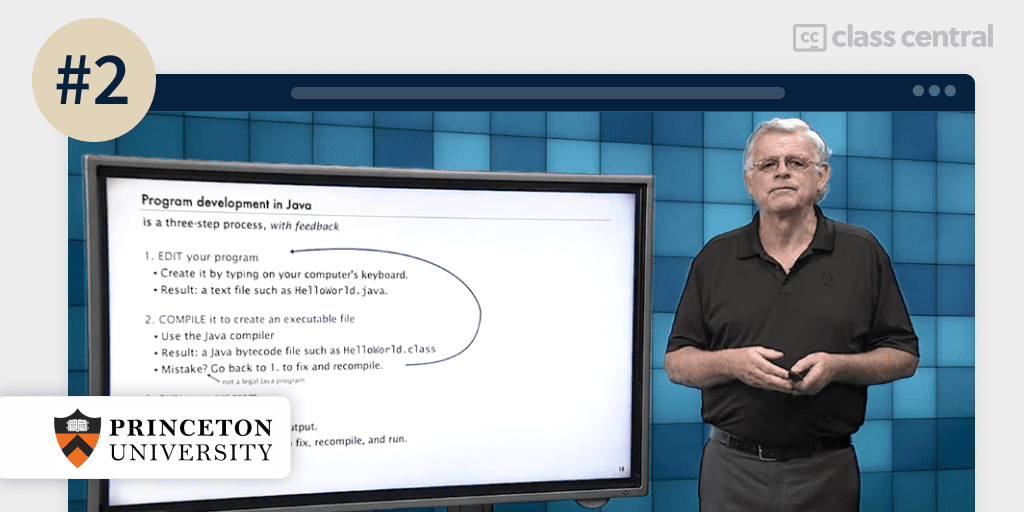
Computer Science: Programming with a Purpose by Princeton University on Coursera is an extremely comprehensive introduction to programming in Java.
Another heavily coding-centered course, this free-to-audit course aims to teach programming in a computational scientific context. After taking this course not only will you be proficient in Java, but you will also understand several fundamental concepts found in other programming languages.
No prior programming experience is required to take this course.
What You’ll Learn
The course begins with a brief history of the Java programming language, before moving into the anatomy of a simple Java program: variables, conditional statements, loops, arrays and more. Every program needs to be interactable, where a program receives an input from the user and displays an output, and you’ll also learn how to implement it in Java.
Next, you’ll learn about Java’s methods and libraries, a cornerstone of modular programming. Modular programming dislikes having a big chunky web of codes and instead prefers neat and clean pieces of code. This will lead to a study of algorithms, which are instructions given to a machine to obtain a desired result. You’ll learn how to measure the efficiency of algorithms through scientific means.
You’ll move on to object-oriented programming in Java. You’ll create your own data types and use them in your programs as abstract representations of real-world concepts. This will culminate into coding a program that uses complex numbers to create visual representations of the famous Mandelbrot set.
The course finally concludes with an overview of important issues surrounding programming languages. The course distinguishes the fundamental features among these languages and addresses fundamental issues, such as garbage collection, type checking, object oriented programming, and functional programming with some brief historical context.
How You’ll Learn
The course is 10 weeks long, with 88 hours worth of material. You’ll watch and learn from a lot of video lectures and some supplemental readings. All of the programming exercises (of which there are many!) in this course are available to everyone.
| Institution | Princeton University |
| Provider | Coursera |
| Instructors | Robert Sedgewick and Kevin Wayne |
| Level | Beginner |
| Workload | 90–100 hours total |
| Enrollments | 161K |
| Rating | 4.7 / 5.0 (650) |
| Certificate | None |
Fun Facts
- This course has over 900 bookmarks on ClassCentral.
- Computer Science: Programming with a Purpose covers the first half of the book Computer Science: An Interdisciplinary Approach.
- The other half of the book is covered by the next course, Computer Science: Algorithms, Theory, and Machines.
- Robert Sedgewick has written over 20 books, his most popular book being Algorithms — with Kevin Wayne as the co-author.
If you’re interested in this course, you can find more information about the course and how to enroll here.
3. Introduction to Java Programming: Starting to code in Java (Universidad Carlos iii de Madrid)
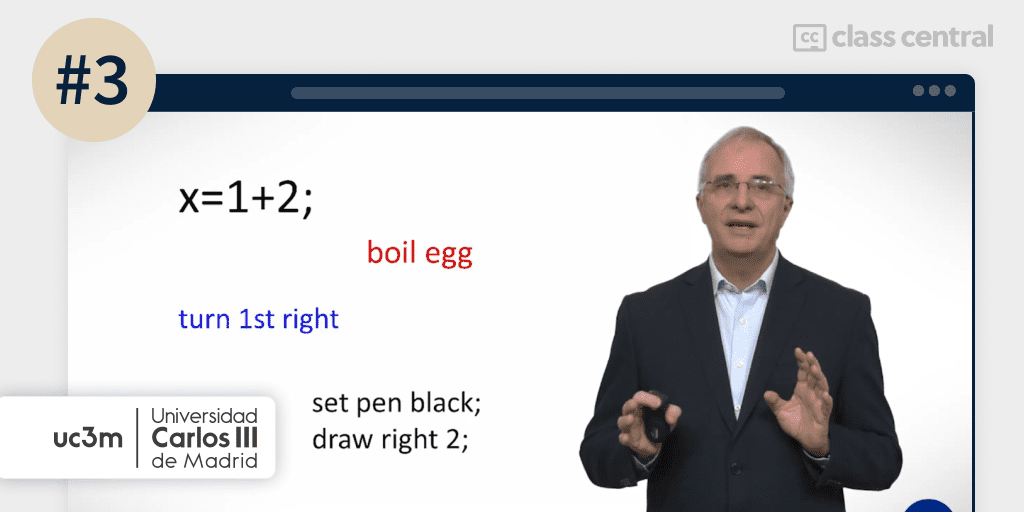
Introduction to Java Programming: Starting to code in Java will teach you how to write code in Java, understand the basics of OOP and how to use software engineering techniques.
The free-to-audit 5 weeks of limited access course introduces programming on the basis of familiar concepts, like calculators and games. Powerful concepts such as functional abstraction, the object oriented programming (OOP) paradigm and Application Programming Interfaces (APIs) will be covered as the course progresses.
No prior experience with programming is required to take this course.
What You’ll Learn
The course is organized into three five-week modules: 1. Learn the basics of the Java programming language; 2. How to write good programs, efficient and correct ones; 3. deal with data structures.
First off, the course introduces you to fundamental programming concepts, like values and expressions, how to implement decision-making in your program, and add on to the functionality of your program with loops.
Then the course moves on to a discussion of methods: reusable blocks of code that can be called anywhere in the program. This will lead you to design and implement recursive algorithms.
You’ll also be introduced to the object-oriented programming (OOP) paradigm. You’ll study the basic mechanism behind OOP like inheritance and polymorphism, and why it is preferred to have reusable pieces of code.
How You’ll Learn
This course is 5 weeks long, with 7—10 hours a week of expected study. You’ll learn primarily from watching the video lectures and supplementary materials supplied by the course.
The course uses three visual and simple tools that make the development of small programs easier: Blockly, Codeboard, and Greenfoot. Blockly allows you to program using blocks and avoiding syntax errors, Codeboard, which helps you see more details about the syntax of Java, and Greenfoot is an IDE (Integrated Developed Environment) that you’ll install on your own computer.
Each week comes with a lab and an exam that will drill you on what was taught. Examples and case studies will also be provided so that you can implement simple programs on your own or collaborate with peers.
| Institution | Universidad Carlos iii de Madrid |
| Provider | edX |
| Instructor | Carlos Delgado Kloos, Carmen Fernández Panadero, and Iria Estévez-Ayres |
| Level | Beginner |
| Workload | 35—50 hours total |
| Enrollments | 353K |
| Certificate | Paid |
Fun Facts
- The course has 1.4K bookmarks on Class Central.
- This course is part of the Introduction to Java Programming Professional Certificate, with the next course being Introduction to Java Programming: Writing Good Code.
If you’re interested in this course, you can find more information about the course and how to enroll here.
4. Introduction to Object-Oriented Programming with Java I: Foundations and Syntax Basics (Georgia Institute of Technology)
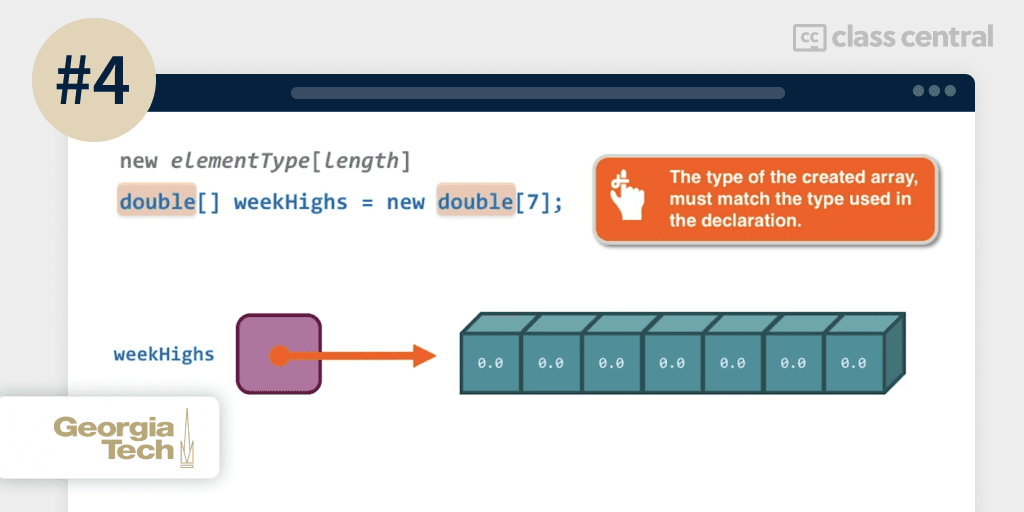
This free-to-audit 6 weeks of limited access course will teach just enough Java to help you develop interactive console programs with basic data processing and formatting capabilities.
Introduction to Object-Oriented Programming with Java I: Foundations and Syntax Basics by Georgia Tech will provide you with a foundational overview and history of Java, as well as its object-oriented paradigm.
Students are expected to have introductory programming experience and be able to perform simple commands on a terminal or command line program.
What You’ll Learn
The course begins with an introduction to Java. You’ll go over Java’s history and motivation briefly before learning the anatomy of a Java program.
Once you know the elements that make up a simple Java program, you’ll explore the object-oriented programming (OOP) paradigm. The course covers the basics of OOP like classes and objects, and fundamental pillars like encapsulation and inheritance.
The course then reels back in the programming concepts. You’ll learn in-depth on writing arithmetic operations, conditionals, loops, arrays, console input and output, and methods to create the final program in this course — recreating the battleship game.
How You’ll Learn
This course is 6 weeks long, with each week taking 5—6 hours of study. The course provides a set readings, video slides, and video demos for you to learn from.
Regarding assessments, there are three homeworks for you to complete to build up on your foundational knowledge of Java.
| Institution | Georgia Institute of Technology |
| Provider | edX |
| Instructor | Olufisayo Omojokun |
| Level | Beginner |
| Workload | 30—36 hours total |
| Enrollments | 13K |
| Certificate | Paid |
Fun Facts
- The course has 60 bookmarks on Class Central.
- I recommend you take the next course in this series after completing this one as it will bring you further in the realm of Java programming.
- Olufisayo Omojokun is the Director of the Division of Computing Instruction at Georgia Tech’s College of Computing.
- This course was recognized as one of Class Central’s 100 most popular (free) online courses of 2021.
If you’re interested in this course, you can find more information about the course and how to enroll here.
5. Intro to Java Programming – Course for Absolute Beginners (freeCodeCamp)
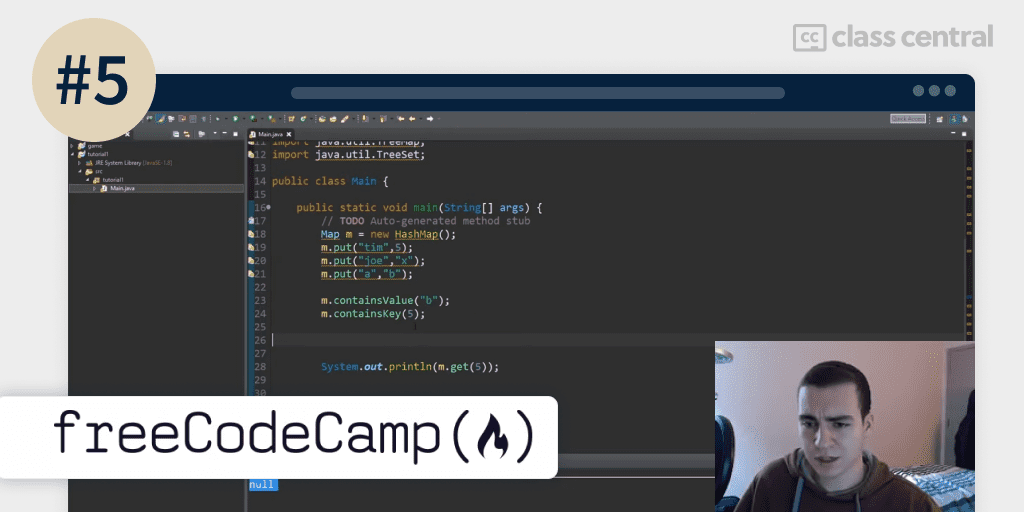
If you’re strapped for time, this free 4-hour course by Tim Ruscica will certainly make you feel like you’ve learned more than that!
This course teaches you Java from the very beginning, from setting up a Java environment in Eclipse and creating methods all the way to object-oriented programming and enums. Hence, no prior programming experience is needed to take this course.
What You’ll Learn
The course begins going over the basics you’ll need to create a simple Java program. This involves you learning what variables are, data types, mathematical and logical operators, reading input from the user and displaying an output, along with conditional statements and loops.
The course then dives deeper into the available data structures in Java, like arrays, sets, and lists. You’ll spend some time learning about maps and hashmaps — extremely efficient data structures that you’ll have no problem implementing in your program once you’ve learned it.
Afterwards, you’ll learn about object-oriented programming (OOP) in Java. You’ll learn what objects and classes are, and what it means for a class to inherit from another class. The course then wraps up this course with a few advanced Java topics, like interfaces and enums.
How You’ll Learn
This course is a 4-hours long video where you’ll learn by watching and following along the instructor in your code editor. There are no exercises provided in this course.
| Institution | freeCodeCamp |
| Provider | YouTube |
| Instructor | Tim Ruscica |
| Level | Beginner |
| Workload | 4 hours total |
| Views | 1.5M |
| Likes | 27K |
| Certificate | None |
Fun Facts
- The course uses the Eclipse integrated development environment for Java programming.
- Tim Ruscica has a YouTube channel called Tech With Tim, where he speaks about various programming languages and concepts.
If you’re interested in this course, you can find more information about the course and how to enroll here.
6. Java Programming: Solving Problems with Software (Duke University)
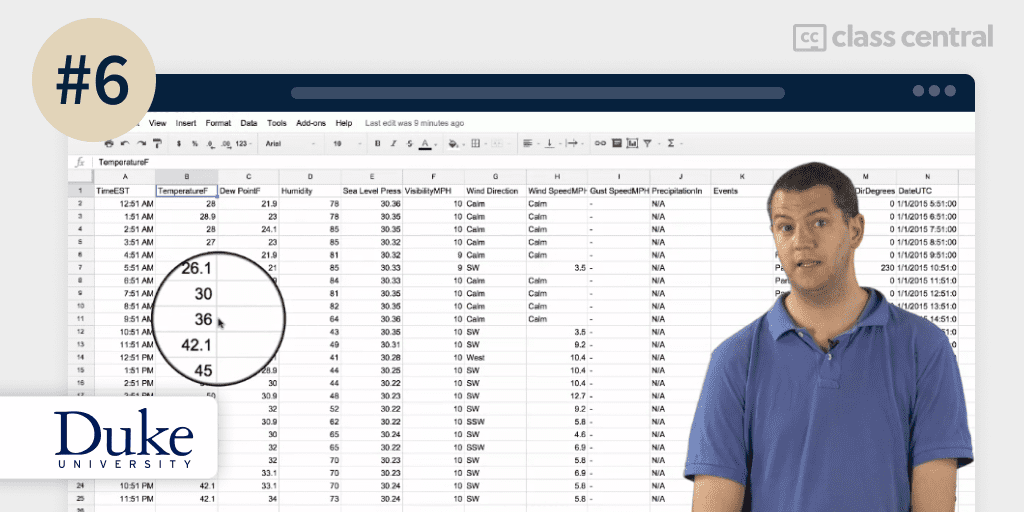
Offered by Duke University, Java Programming: Solving Problems with Software builds up your knowledge of Java such that you can work on issues such as analyzing DNA, manipulating CSV files, and processing images.
In this free-to-audit course, you’ll learn how to design, develop, and debug any program following a simple seven-step process. Additionally, you’ll learn how to formulate algorithms using the divide-and-conquer paradigm. By the end of the course, you’ll build a program that determines the popularity of different baby names in the US over time by analyzing comma separated value (CSV) files.
No prior experience with programming is required to take this course.
What You’ll Learn
In this course, you’ll learn the fundamentals of programming, which includes learning the syntax and semantics of Java. Syntax can be likened to spelling and grammar, while semantics is the meaning you want to convey to the program. While both are important for creating a functioning program, knowing the semantics will help you significantly in your programming endeavor by allowing you to express exactly what you want in any shape or form.
After learning the basic concepts of programming, like variables, loops, and methods, you’ll quickly move on to learning by doing. Your first encounter with strings (series of characters) will have you find genes within a DNA and links in web pages.
The course will also introduce many methods to help you process data in many formats. You’ll complete a variety of simple projects in Java using techniques that help you scale what you’ve coded into larger programs and larger problems. For example, you’ll work with the Apache Commons CSV package to help you with questions too complex to answer with a primitive Excel spreadsheet.
How You’ll Learn
4 weeks long, with each week taking 4—8 hours. You’ll learn by watching lecture videos and through completing graded coding assignments, which are only accessible to paying learners. Practice quizzes are, however, available to everyone.
| Institution | Duke University |
| Provider | Coursera |
| Instructors | Owen Astrachan, Robert Duvall, Andrew D. Hilton and Susan H. Rodger |
| Level | Beginner |
| Workload | 16—32 hours total |
| Enrollments | 308K |
| Rating | 4.6 / 5.0 (7.1K) |
| Certificate | Paid |
Fun Facts
- The course has 781 bookmarks on Class Central.
- It has a companion website at dukelearntoprogram.com that acts as a reference guide.
If you’re interested in this course, you can find more information about the course and how to enroll here.
7. Object Oriented Programming in Java (University of California, San Diego)
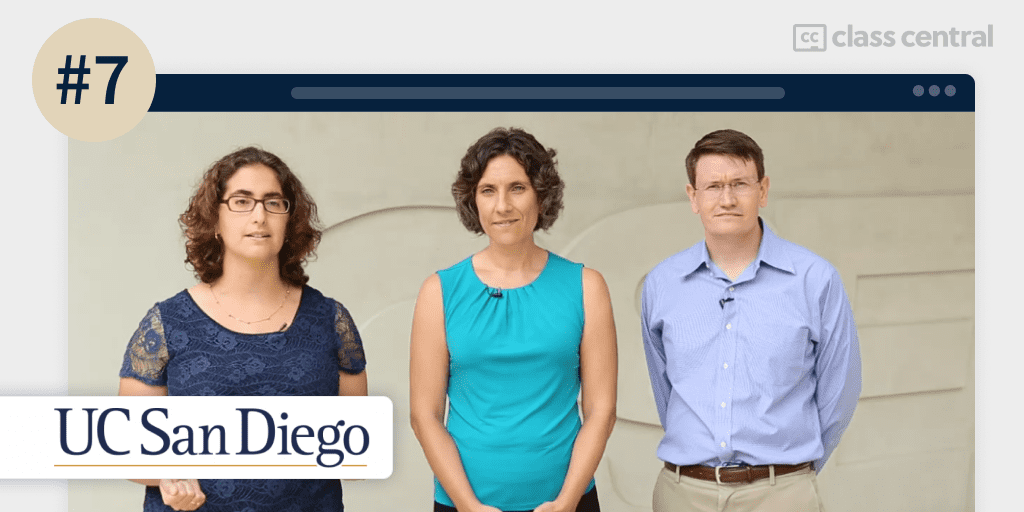
If you have taken some introductory-level Java courses and want to go beyond, Object Oriented Programming in Java by the University of California, San Diego will help you do just that. Specifically, you’ll focus on data visualization in Java.
This course takes a project-oriented approach where you’ll develop an interactive application that visualizes earthquake data live on a map. You’ll become familiar with Java’s in-built libraries, design and implement classes to create responsive GUIs, and learn how to sort and search through a large geospatial dataset with algorithms and data structures.
What You’ll Learn
The course first begins with an introduction to the fundamentals of object-oriented programming in Java, where you’ll discuss topics like class hierarchies, inheritance and polymorphism. You’ll also learn how to debug code in Java by tracing the execution of code using memory-models.
You’ll extend your knowledge of object-oriented programming through GUI programming. One of the things you’ll learn is how polymorphism affects compile-time and run-time decisions in Java. Lastly, you’ll study a couple core algorithms that sort and search data and data structures that store map information, where you’ll understand that some algorithms are more efficient than others.
How You’ll Learn
This course is 6 weeks long, with each week taking 4—6 hours. You’ll learn from the videos and reading materials provided in the course.
The course is structured around completing one main application — an earthquake map visualization application. The course provides multiple programming assignments that build concepts and designs on top of one another until you end up with a complete application. If you are a paying learner, you’ll be able to share your final product with your peers and receive feedback from them, along with access to graded quizzes each week.
| Institution | University of California, San Diego |
| Provider | Coursera |
| Instructors | Mia Minnes, Leo Porter and Christine Alvarado |
| Level | Intermediate |
| Workload | 24—36 hours total |
| Enrollments | 253K |
| Rating | 4.7 / 5.0 (5.4K) |
| Certificate | Paid |
Fun Facts
- The course has 1.7K bookmarks on Class Central.
- It is part of the Object Oriented Programming in Java Specialization, with the next course being Java Programming: Arrays, Lists, and Structured Data.
If you’re interested in this course, you can find more information about the course and how to enroll here.
8. Introducción a la programación orientada a objetos en Java (Universidad de los Andes)
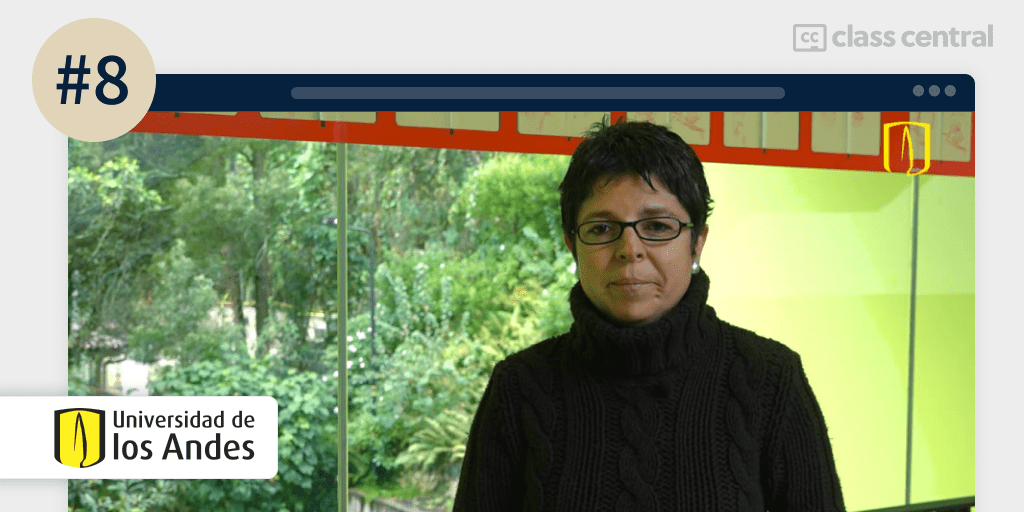
If you understand Spanish, this free-to-audit course by Universidad de los Andes might be for you!
Introducción a la programación orientada a objetos en Java aims to prepare you with fundamental knowledge and skills needed for object-oriented programming.
A unique aspect of this course is that it takes an active approach to learning through gamification. Every activity in the course will earn you points, helping you measure your progress and understand which aspects of your programming skill you should improve.
Although this course is for those who already know how to program but not necessarily in Java or in the object-oriented programming paradigm, it does offer an e-book for first-time programmers to learn from.
What You’ll Learn
In this course, you’ll learn the fundamentals of the object-oriented programming (OOP) paradigm. You’ll be given a lengthy tour of the 5 pillars of OOP: abstraction, encapsulation, modularity, polymorphism, and inheritance. Then, the course shifts gears to discussing a couple of basic data structures like arrays and vectors where you’ll also learn about the different algorithms used to sort and search through them. Having a solid foundation of algorithms and data structures will help you better understand how to make your programs much more efficient and quick.
The course switches back to OOP and starts diving deeper into inheritance. When you are tasked to develop a project, it is inevitable that some aspects of the project start to shift and change. OOP helps us by giving us a base to build our application on and avoid having to redo our application whenever a specification changes. It is here you’ll learn about intermediate Java OOP concepts like superclasses, subclasses, and abstract classes. Once you have these concepts at your fingertips, you’ll find it easier to develop a graphical user interface from scratch in Java, which makes up the final module of this course.
How You’ll Learn
The course consists of 4 modules, with each module taking 14 hours to complete. You’ll learn mainly from watching instructor videos and working on the various activities the course provides ranging from theory quizzes to programming assignments. Completing each activity will earn you puntos de experiencia, puntos de competencia, and puntos de habilidad. These points will help you track your progress throughout the course.
| Institution | Universidad de los Andes |
| Provider | Coursera |
| Instructors | Marcela Hernández Hoyos, Álvaro Andrés Gómez D’Alleman and Juan Pablo Reyes Gómez |
| Level | Intermediate |
| Workload | 56 hours total |
| Enrollments | 53K |
| Rating | 4.6 / 5.0 (257) |
| Certificate | Paid |
Fun Facts
- The course has 167 bookmarks on Class Central.
- Due to its unique approach to gamifying assignments, this course is part of Class Central’s 250 top free Coursera courses of all time.
- You’ll use a code editor called Eclipse as your main development environment.
If you’re interested in this course, you can find more information about the course and how to enroll here.
9. Java for Beginners (JetBrains Academy)
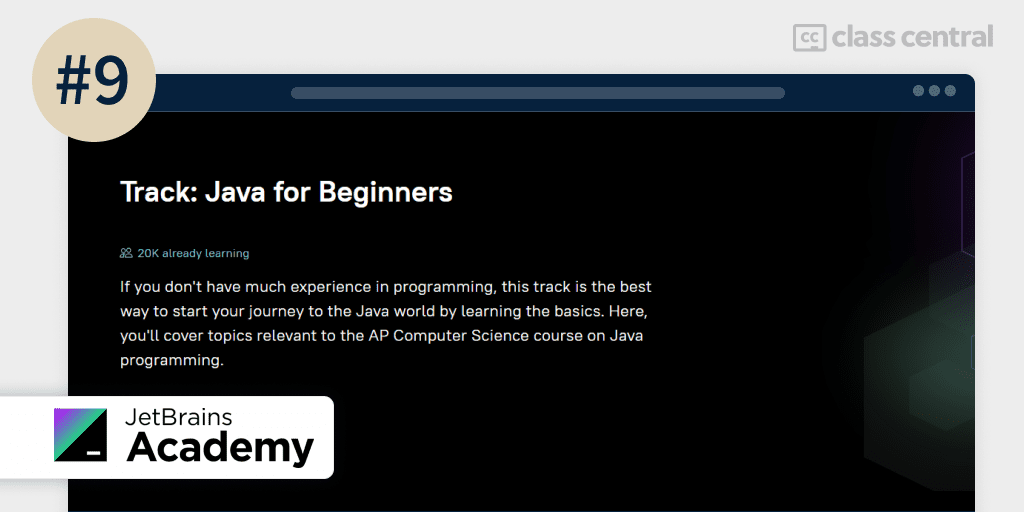
If you don’t have much experience in programming, this paid course (with up to 2 months of free trial) by JetBrains Academy will help you learn the basics of Java through project-based learning. If you’re an AP Computer Science student, lucky for you this course covers every topic relevant to Java programming.
A nice feature about this course is that it gives you a selection of projects with 4 levels of difficulty ranging from easy for beginners to challenging for the pros.
As this course was developed by the creators of IntelliJ, the course integrates seamlessly into IntelliJ. All code will be run and tested through the IDE.
What You’ll Learn
The course begins with the basics of Java programming. You’ll learn how to create simple programs in Java with data types and variables, control flow statements, and loops. You’ll also be introduced to a couple of Java programming-related concepts like the Java Virtual Machine, algorithms and data structures, and using the IntelliJ IDE.
Afterwards, you’ll explore the basic idea of object-oriented programming (OOP). You’ll learn about classes and objects, and how classes can inherit from other classes. Encapsulation is also another important pillar of OOP, and you’ll see how it is used in conjunction with unit testing.
You’ll also study a few concepts to make you a truly knowledgeable programmer, like working with different types of data like arrays, files, and IO streams and organizing your code in a neat and tidy manner to help others (and your future self) understand what you were trying to do in a year’s time, and handling runtime errors.
How You’ll Learn
15 weeks to complete the track if you study 5 hours a week, 74 hours for all learning activities. You’ll learn from doing a lot of hands-on coding from following the written instructions given in the course and submitting your answer. Additionally, you’ll have to complete a programming project of your choice to receive your certificate.
| Institution | JetBrains Academy |
| Level | Beginner |
| Workload | 75 hours total |
| Enrollments | 20K |
| Rating | 4.6 / 5.0 |
| Certificate | Paid |
Fun Facts
- The course also includes a section on computational math like binary and hexadecimal systems for those unfamiliar with it.
If you’re interested in this course, you can find more information about the course and how to enroll here.
10. Java Programming Masterclass covering Java 11 & Java 17 (Learn Programming Academy)
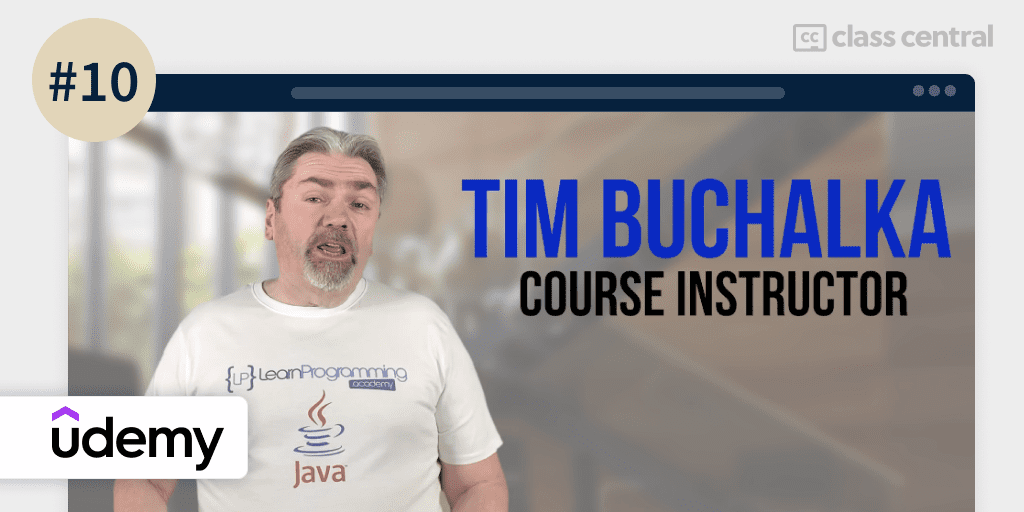
In this paid course, Tim Buchalka teaches the core Java skills needed to get employed as a Java programmer, if you’ve programmed before or if you have not.
By the end of this course, you’ll have the foundational knowledge needed to transition to the Spring Framework, Java EE, Android development, etc as well as be prepared to take the Oracle Java Certificate exam.
One thing I like about this course is that it is constantly updated, so you’ll never have to worry about learning outdated syntax and formats.
What You’ll Learn
You’ll start this course with an introduction to the basic concepts of programming. First, you’ll be taught the four stages of becoming a programmer as well as the mindset you should adopt when learning programming. Then, you’ll get up and running with the basic syntax of Java, that is, the Java vocabulary. Your first introduction to Java will consist of learning what variables are, how to write an expression in Java, and the like.
As Java is an object-oriented programming (OOP) language, the course teaches you right away the OOP paradigm or style. You’ll learn the principles of OOP and why OOP is so popular.
The course also digs into the little quirks of Java that most developers have to get comfortable with. For example, you’ll learn how to work with Java packages, scopes, private and public classes, and more. You’ll also learn more advanced programming topics like the common data structures and algorithms needed to build efficient programs.
Lastly, the course wraps up with advanced Java programming. Things like concurrency (running 2 lines of code simultaneously), lambda expressions, debugging and unit testing, network programming, and databases will be covered to help you solidify your understanding.
How You’ll Learn
This course is 80 hours long, split into 25 sections. You’ll learn primarily through watching the detailed lecture videos, and completing the coding exercises. Each section consists of one or more coding exercises to help you practise your Java programming skills as well as useful resources.
| Institution | Learn Programming Academy |
| Provider | Udemy |
| Instructor | Tim Buchalka |
| Level | Beginner |
| Workload | 80 hours total |
| Enrollments | 673K |
| Rating | 4.6 / 5.0 (160K) |
| Certificate | Paid |
Fun Facts
- The course uses the IntelliJ integrated development environment for Java programming.
- Tim Bulchaka has been a professional software developer for close to 40 years, having worked with Fujitsu, Mitsubishi, and Saab.
- He has over 1 million students on Udemy alone.
If you’re interested in this course, you can find more information about the course and how to enroll here.

